'A Simulacrum' review — a magic show with a new bag of tricks
The world premiere play by Lucas Hnath goes behind the curtain and investigates the process of developing magic tricks with sleight-of-hand artist Steve Cuiffo.
Lucas Hnath’s new play is kind of like a magic show. A Simulacrum stars sleight-of-hand artist Steve Cuiffo — and also, somewhat, Hnath, whose recorded voice, in dialogue with Cuiffo, booms from a tape recorder on Atlantic Theater’s stage. It begins with Cuiffo walking on stage and pressing play on a cassette player, and Hnath saying, “Steve, show me a magic trick.”
Center Theatre Group originally commissioned Hnath to write a magic show, but he was more interested in crafting a stage documentary to go behind the magic. Hnath has endless intellectual curiosity, and his works often analyze particular subjects in depth. Hnath’s The Thin Place explores psychic mediums and the liminal space between life and death; The Christians probes faith in America; and Red Speedo dives into the world of Olympic swim trials. A Simulacrum investigates the making of magic.
To create A Simulacrum, Hnath and Cuiffo met for a weeklong workshop that gave way to more. The friends culled the 90-minute play from more than 50 hours of dialogue between them over the course of about a year. With the help of an earpiece, Cuiffo recreates his side of the conversations live, complete with every utterance and sound of movement. It’s a challenging feat of synchronization, and the charming Cuiffo holds his own on stage. Cuiffo drives the energy forward with his genuine pleasure of performing magic tricks, many of which he’s likely performed for decades.
Hnath’s recorded voice plays along, asking questions about Cuiffo’s practiced magic performance and responding to his tricks with delight. Hnath, also the director, poses questions but never asks Cuiffo to reveal the step-by-step process or manual dexterity necessary to perform tricks successfully. Rather, Hnath delves into Cuiffo’s relationship with magic and the motives behind his routine.
Cuiffo proudly demonstrates classic card tricks and a cups and balls routine. He makes a silver dollar defy gravity and even restores a shredded newspaper with rubber cement — and perhaps a bit of magic? To contextualize each trick for Hnath, Cuiffo reads from texts by the famous magicians who created them, including S. W. Erdnase and Dr. Jacob Daley.
“There’s all this verbatim work that you described where you’re doing an exact recreation of such-and-such magician’s routine from such-and-such a time,” says Hnath through the recorder. “And I guess what it’s leaving me wondering is: Where is Steve in this?”
Ahead of their next workshop, Hnath challenges Cuiffo to build some tricks of his own, including one his magic-hating wife will love and another that will equivocally fail. The latter half of the play chronicles the development of Cuiffo’s new, impressive bag of tricks and the personal challenges of creating something for someone you love. Hnath’s assignment for Cuiffo results in the most compelling trick involving a vintage suitcase, a baby doll, and, well, what can only be described as magic.
A simulacrum is a representation of something else, and in many ways, the play is a rendering of the process of developing a play. It is also a rendering of the challenge of building a new trick while confronting the possibility of failure. And like a good magic routine, A Simulacrum begins with something ordinary and ends with something astounding.
A Simulacrum is at Atlantic Stage 2 through July 2.
Top image credit: Steve Cuiffo in A Simulacrum at Atlantic Theater Company. (Photo by Ahron R. Foster)
Originally published on
